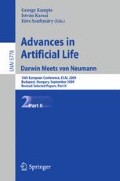Abstract
We test the controversial ideas about the role of corridors in fragmented animal habitats. Using simulation studies we analyze how fragmentation affects a simple prey-predator system and how the introduction of openings that connect the habitats changes the situation. Our individual based model consists of 3 levels: renewable prey food, as well as prey and predators that both have a simple economy. We find, in line with intuition, that the fragmentation of a habitat has a strong negative effect especially on the predator population. Connecting the fragmented habitats facilitates predator (and hence prey) survival, but also leads to an important counterintuitive effect: in the presence of a high quality predator, connected fragmented systems fare better in terms of coexistence than do unfragmented systems. Using a frequency domain analysis we explain how corridors between sub-habitats serve as “wave breakers” in the population flow, thus preventing deadly density waves to occur.
Access this chapter
Tax calculation will be finalised at checkout
Purchases are for personal use only
Preview
Unable to display preview. Download preview PDF.
References
Boerlijst, M.C., Lamers, M.E., Hogeweg, P.: Evolutionary consequences of spiral waves in a host-parasitoid system. Proceedings of the Royal Society of London Series B Biological Sciences 253(1336), 15–18 (1993)
MacArthur, R.H., Wilson, E.O.: The theory of island biogeography. Princeton University Press, Princeton (1967)
Levins, R.: Some demographic and genetic consequences of environmental heterogeneity for biological control. Bulletin of the Entomological Society of America 15, 237–240 (1969)
Hanski, I.: Metapopulation ecology. Oxford University Press, Oxford (1999)
Haddad, N.M., Tewksbury, J.J.: Impacts of corridors on populations and communities. In: Crooks, K., Sanjayan, M. (eds.) Connectivity Conservation, pp. 390–415. Cambridge University Press, Cambridge (2006)
Helbing, D.: A fluid-dynamic model for the movement of pedestrians. Complex Systems 6, 391–415 (1992)
Karsai, I., Kampis, G.: Connected fragmented habitats facilitate stable coexistence dynamics. Ecological Modelling 222, 447–455 (2011)
Author information
Authors and Affiliations
Editor information
Editors and Affiliations
Rights and permissions
Copyright information
© 2011 Springer-Verlag Berlin Heidelberg
About this paper
Cite this paper
Kampis, G., Karsai, I. (2011). Breaking Waves in Population Flows. In: Kampis, G., Karsai, I., Szathmáry, E. (eds) Advances in Artificial Life. Darwin Meets von Neumann. ECAL 2009. Lecture Notes in Computer Science(), vol 5778. Springer, Berlin, Heidelberg. https://doi.org/10.1007/978-3-642-21314-4_13
Download citation
DOI: https://doi.org/10.1007/978-3-642-21314-4_13
Publisher Name: Springer, Berlin, Heidelberg
Print ISBN: 978-3-642-21313-7
Online ISBN: 978-3-642-21314-4
eBook Packages: Computer ScienceComputer Science (R0)

